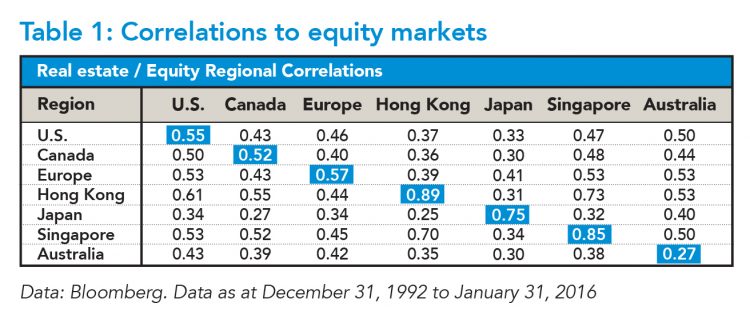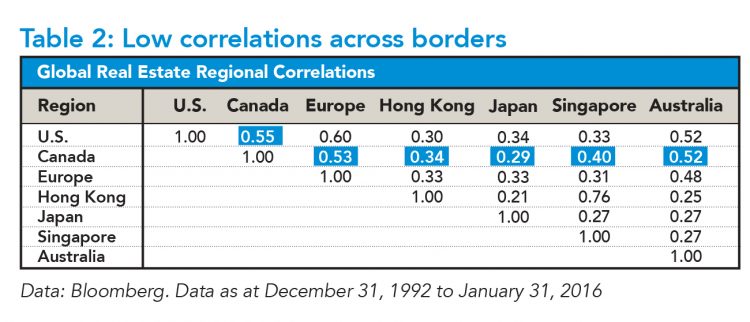
Tighter correlations between traditional asset classes and increasingly volatile equity markets have left investors searching for solutions that add meaningful diversification and stability to their portfolios.
Real estate, whether private or public, stands out among the available options that can deliver what investors are looking for.
Low correlations
Global real estate has an attractive 0.35 correlation to global bonds, and a 0.77 correlation to global equities.1 The latter figure appears high, but it doesn’t tell the whole story. Consider the more nuanced picture presented in Table 1, below.
For the most part, correlations between global real estate and equities are low; there are only a handful of areas – focused in Asia – where correlations spike. For example, Hong Kong real estate is highly correlated to its local equity market. The same is true of Japan and Singapore. Conversely, Canadian real estate has a low correlation to its local equity market, with the same being true of the U.S., Europe and Australia. In addition, correlations between specific real estate markets and foreign equity markets are, with few exceptions, markedly low.
Skilled active management can counteract the few instances of elevated correlations. “Underweighting those markets, and overweighting markets that have low correlations to equity markets, will bring down the overall correlation to equities,” explains Corrado Russo, Senior Managing Director, Investments and Global Head of Securities, Timbercreek Asset Management, a global asset manager specializing in real estate.
Low correlations are also observed within global real estate. Canada’s real estate market has a 0.55 correlation to U.S. real estate, 0.53 to Europe, 0.34 to Hong Kong, 0.29 to Japan, 0.4 to Singapore and 0.52 to Australia, as indicated in Table 2, below.2
The reason for these low correlations is that “real estate, unlike other asset classes, is entirely local,” says Russo. “If you need an office in Tokyo, you can’t substitute one in Toronto.” This stands in stark contrast to the extremely high correlations we observe across regional equity markets.
Low volatility
Many investors are gravitating towards strategies that lower the overall volatility of their portfolios. One reason is to avoid the psychological discomfort that can result from increasingly volatile equity markets. Another reason is based on an important investment rationale: exposure to significant market downturns reduces the impact of future gains.
Lowering volatility is effectively a “win more by losing less” strategy. If an investor’s portfolio loses half of its value, it needs a 100% return just to get back to its pre-downturn level. By reducing volatility, the investor boosts long-term returns by making future gains add to portfolio growth, rather than simply make up for previous losses.
Unlike equities, real estate investments – whether private or publicly traded – can create this low-volatility cushion for portfolios. “If you look at equities, sector by sector, what you find is that most companies’ earnings are immediately responsive to economic events,” notes Russo. For example, if China devalues the yuan and cuts its resource intake, global economic growth is reduced and stocks’ earnings per share see an almost-immediate negative impact.
Because they’re based on long-term leases, real estate investments are more insulated from such events. Russo explains: “If you have an average lease term of seven years, and the average economic cycle is seven years, you won’t hit the bottom of the cycle. By the time the leases roll over, the economy will be coming out of the trough.” By smoothing out the low points, long-term leases create more even cash flows, lowering volatility.
Smart leverage
Some worry that the leverage used in real estate investing introduces risks that could increase volatility. A comprehensive risk-management process, which includes a local presence in key markets, can alleviate these concerns.
Russo notes that matching the amount of leverage to the characteristics of the property – location, tenant quality, lease terms – allows the fund manager to effectively dampen risk. For example, a mall in an affluent neighbourhood with long lease terms and the highest credit-quality tenants could safely take 70% to 75% leverage. A property that does not have these attributes to the highest degree should involve less leverage. A conservative average for a portfolio of real estate holdings will typically fall in the range of 60% to 65% leverage.
Solving problems for today’s investor
Real estate – both private and publicly traded – is a proven solution for investors seeking greater diversification and lower volatility.
Guided by experienced active management, real estate investors can also achieve reliable income streams and consistent long-term growth.
Timbercreek Asset Management is a global expert in private and publicly traded real estate investments, focused on delivering predictable, sustainable and growing returns to investors.
For more information on Timbercreek’s investment solutions, visit Timbercreek.com/advisors
1Source: Bloomberg. Data as at December 31, 1992 to January 31, 2016. Indices include FTSE EPRA NAREIT Developed Global Real Estate Index, S&P/TSX Composite Index and the JP Morgan Global Aggregate Bond Index.
2Source: Bloomberg. Data as at December 31, 1992 to January 31, 2016.
Partner Report is a space made available for businesses who wish to publish content for financial professionals. Investment Executive journalists are not involved in writing these articles.

